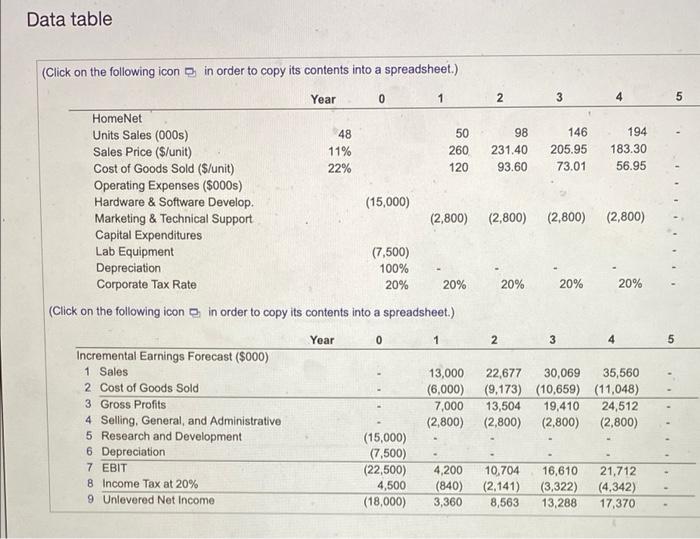You are evaluating the HomeNet project under the following assumptions: Sales of 50,000 units in year 1 increasing by 48,000 units per year over the life of the project, a year 1 sales price of $260/unit, decreasing by 11% annually and a year 1 cost of $120/unit decreasing by 22% annually. In addition, new tax laws allow 100% bonus depreciation (all the depreciation expense occurs when the asset is put into use, in this case immediately). Research and development expenditures total $15 million in year and selling, general, and administrative expenses are $2.8 million per year (assuming there is no cannibalization). Under these assumptions the unlevered net income is shown in the table: B Suppose that HomeNet will have no incremental cash or inventory requirements (products will be shipped directly from the contract manufacturer to customers). However, receivables related to HomeNet are expected to account for 15% of annual sales, and payables are expected to be 15% of the annual cost of goods sold. a. Calculate HomeNet's net working capital requirements (that is, reproduce Table 8.4 under the assumptions given) b. Calculate HomeNet's FCF (that is, reproduce Table 8.3 under the same assumptions). Data table (Click on the following icon in order to copy its contents into a spreadsheet.) 2 3 4 5 98 231.40 93.60 146 205.95 73.01 194 183.30 56.95 Year 0 1 HomeNet Units Sales (000s) 48 50 Sales Price ($/unit) 11% 260 Cost of Goods Sold ($/unit) 22% 120 Operating Expenses ($000s) Hardware & Software Develop. (15,000) Marketing & Technical Support (2,800) Capital Expenditures Lab Equipment (7,500) Depreciation 100% Corporate Tax Rate 20% 20% (Click on the following icon in order to copy its contents into a spreadsheet.) (2,800) (2,800) (2,800) 20% 20% 20% Year 0 1 2 3 4 5 Incremental Earnings Forecast ($000) 1 Sales 2. Cost of Goods Sold 3 Gross Profits 4 Selling, General, and Administrative 5 Research and Development 6 Depreciation 7 EBIT B Income Tax at 20% 9 Unlevered Net Income 13,000 (6,000) 7,000 (2,800) 22,677 30,069 35,560 (9,173) (10,659) (11,048) 13,504 19,410 24,512 (2,800) (2,800) (2,800) (15,000) (7,500) (22,500) 4,500 (18,000) 4,200 (840) 3,360 10,704 (2.141) 8,563 16,610 (3,322) 13,288 21,712 (4.342) 17,370 Data table 0 1 2 3 4 5 (Click on the following icon in order to copy its contents into a spreadsheet.) HomeNet's Net Working Capital Requirements Year Net Working Capital Forecast ($000) 1 Cash Requirements 2 Inventory 3 Receivables (15% of sales) 4 Payable (15% of COGS) 5 Net Working Capital 3,525 (1,425) 2,100 3,525 3,525 3,525 - (1,425) (1,425) (1,425) - 2,100 2,100 2,100 - 3 5 23,500 23,500 (9,500) (9,500) 14,000 14,000 (3.000) (3,000) (Click on the following icon in order to copy its contents into a spreadsheet.) Calculation of HomeNet's Free Cash Flow Year 0 1 2 Incremental Earnings Forecast (5000) 1 Sales 23,500 23,500 2 Cost of Goods Sold (9,500) (9,500) 3 Gross Profits 14,000 14,000 4 Selling, General, and Administrative (3,000) (3,000) 5 Research and Development (15,000) 6 Depreciation (1,500) (1,500) 7 EBIT (15,000) 9,500 9,500 8 Income Tax at 20% 3,000 (1,900) (1,900) 9 Unlevered Net Income (12,000) 7,600 7,600 Free Cash Flow (000s) 10 Plus: Depreciation 1,500 1,500 11 Less: Capital Expenditures (7,500) 12 Less: Increases in NWC (2,100) 13 Free Cash Flow (19,500) 7,000 9,100 (1,500) (1,500) (1,500) 9,500 9,500 (1,500) (1,900) (1,900) 300 7,600 7,600 (1,200) 1,500 1,500 1,500 2,100 2,400 9,100 9,100 a. Calculate HomeNet's net working capital requirements (that is, reproduce Table 8.4 under the assumptions given). The net working capital for year 1 is $ (Round to the nearest thousand dollars.) The net working capital for year 2 is $ (Round to the nearest thousand dollars.) The net working capital for year 3 is $ (Round to the nearest thousand dollars.) The net working capital for year 4 is $ (Round to the nearest thousand dollars.) The net working capital for year 5 is $ (Round to the nearest thousand dollar.) b. Calculate HomeNet's FCF (that is, reproduce Table 8.3 under the same assumptions). The free cash flow for year is $ (Round to the nearest thousand dollars.) The free cash flow for year 1 is $ (Round to the nearest thousand dollars.) The free cash flow for year 2 is $ (Round to the nearest thousand dollars.) The free cash flow for year 3 is $ (Round to the nearest thousand dollars.) The free cash flow for year 4 is $ (Round to the nearest thousand dollars.) The free cash flow for year 5 is $ (Round to the nearest thousand dollars.)











